Say you’ve just had ACL surgery. Or you’re recovering from a bad break. Or, worse, you suffer a stroke, or MS, or spinal or neurological damage. Regaining the power to walk is one of the toughest things you can do, and it may be impossible without a crutch, rail, or physical therapist to lean on. The AlterG Bionic Leg — straight out of the sci-fi future — may be the answer you’ve been dreaming of. I should know. I tried it.
Welcome to Fitmodo, Gizmodo’s gym for your brain and backbone. Don’t suffer through life as a snivelling, sickly weakling — brace up, man, get the blood pumping! Check back each week for the latest in fitness science, workout gear, exercise techniques, and enough vim and vigour to whip you into shape.
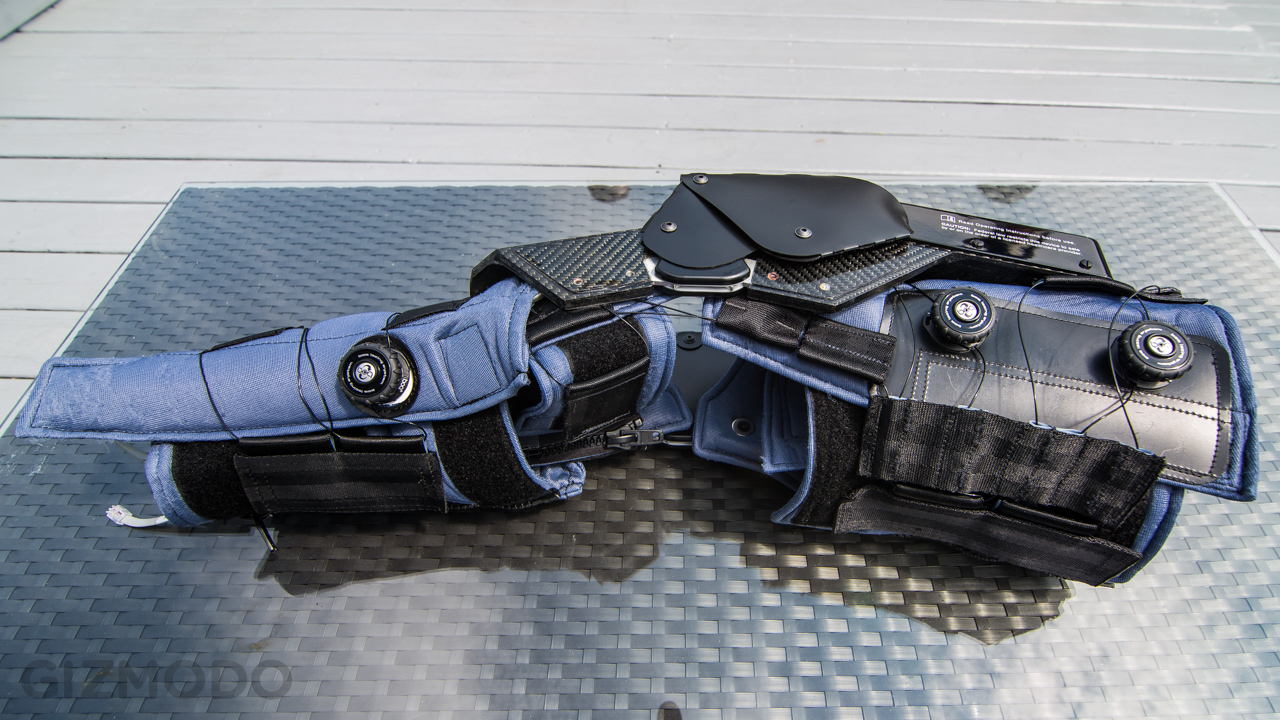
This is the second time little-known company AlterG has blown our minds. Last year it was with a rather impressive anti-gravity treadmill. The Bionic Leg, however, is even more incredible. From the company’s description it’s “the first wearable, mobile robotic exoskeleton for lower extremity physical therapy.” Using it, patients can use their leg as they did before they were injured.
The Bionic Leg provides motorised assistance with extension (straightening your knee), which kicks in when you’re standing up from a seated position, swinging your leg forward between steps, and going up stairs. It also provides resistance for flexion (bending your knee), so it kicks in when you’re lowering yourself down to sitting, squatting, or when you’re going down stairs. It enables patients to move without having to compensate in ways that would slow down their rehab or possibly cause other complications.
For example, the way a person with an injured leg typically goes up a flight of stairs is by leading with their good leg, pushing up onto a step, then bringing their injured leg up to meet it. Then they lead with their good leg again and repeat the process. With the AlterG Bionic Leg, they don’t have to do that. They can walk up the stairs one foot after the other, letting the motors do most of the heavy-lifting on the injured limb, but slowly building strength and control back into it.
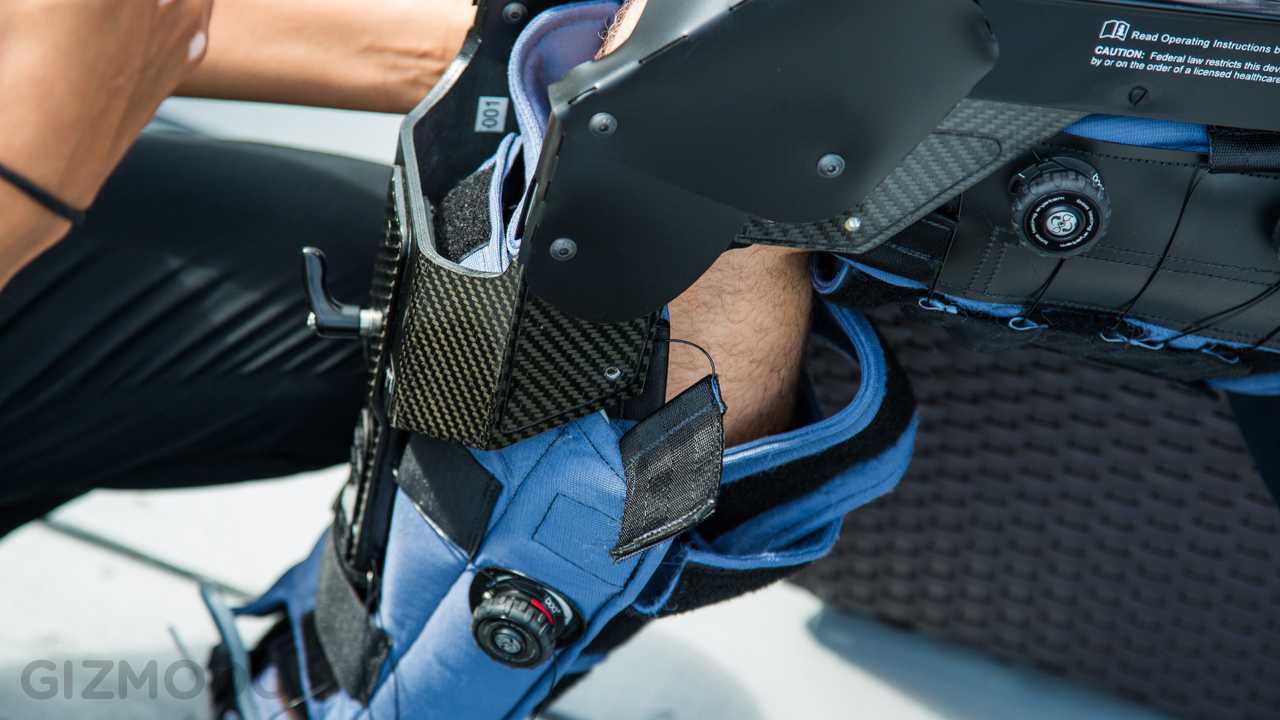
How It Works
You sit down, and a clinician straps the device onto your leg. It’s bulky and intimidating, but its rigidity comes from carbon fibre plates and it only weighs 4kg (the next version will weigh only 3kg). It’s adjustable to fit virtually any-sized leg, and it only takes about three minutes to get all strapped in. The component that makes this thing such a breakthrough doesn’t go on your leg, though; it goes into your shoe.
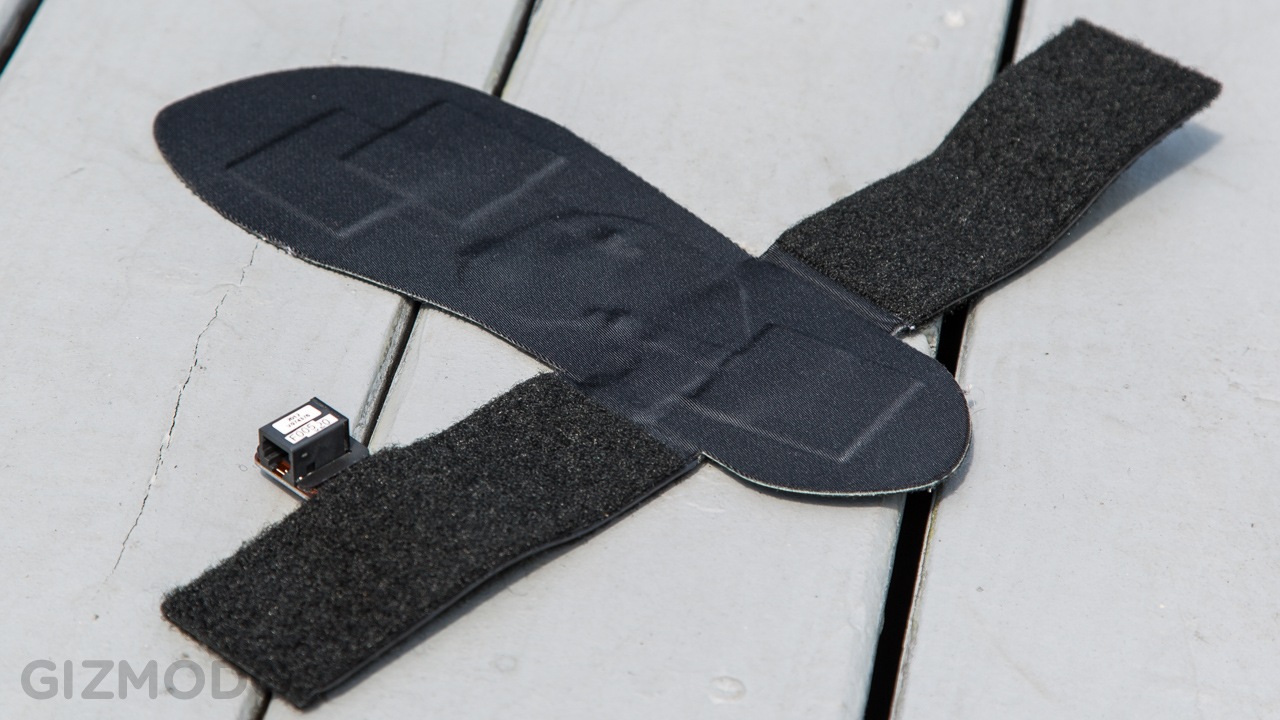
A thin insole with four separate pressure sensors is slipped right into your shoe — whatever you normally wear is fine — and is attached to the rest of the leg. It’s these sensors that allow the leg to assist not passively, but based on your intention. In other words, the pressure your foot applies to the sensors, in tandem with the effort exerted by your knee, tell the bionic leg whether you’re trying to stand up, walk forward, go up a curb, or sit down. It processes that information so quickly that it the reactions feel instantaneous, like it’s reading your mind.
Toward the upper part of the machine is a small LCD screen with some buttons around it. You punch in your weight, and then there are four parameters which can be adjusted:
- Threshold controls the percentage of body weight needed to activate the motors. It can be set for anywhere between five and 50 per cent of the patient’s weight. In other words, a 80km man could set it to 25 per cent, and the assisting motors wouldn’t engage until it senses 20kg of pressure. This number can be adjusted as rehabilitation progresses, so that the leg continues to do as much work as it’s ready for.
- Assistance is simply how much the motors help the patient in extending their leg. It can be set anywhere between zero and 80 per cent. As the he or she improves, this number will be lowered so they are doing more work themselves.
- Resistance is how much resistance it provides during flexion (sitting down, going down stairs, etc). It can be set to low, medium, or high, and it is, essentially, what will keep a weak knee from collapsing unpredictably.
- Extension Limiter would probably only be used for someone with a direct knee/leg injury. For example, if you recently had knee surgery and shouldn’t yet extend your knee all the way, the motors will only help you until you get to a certain degree of extension. It basically saves you from yourself.
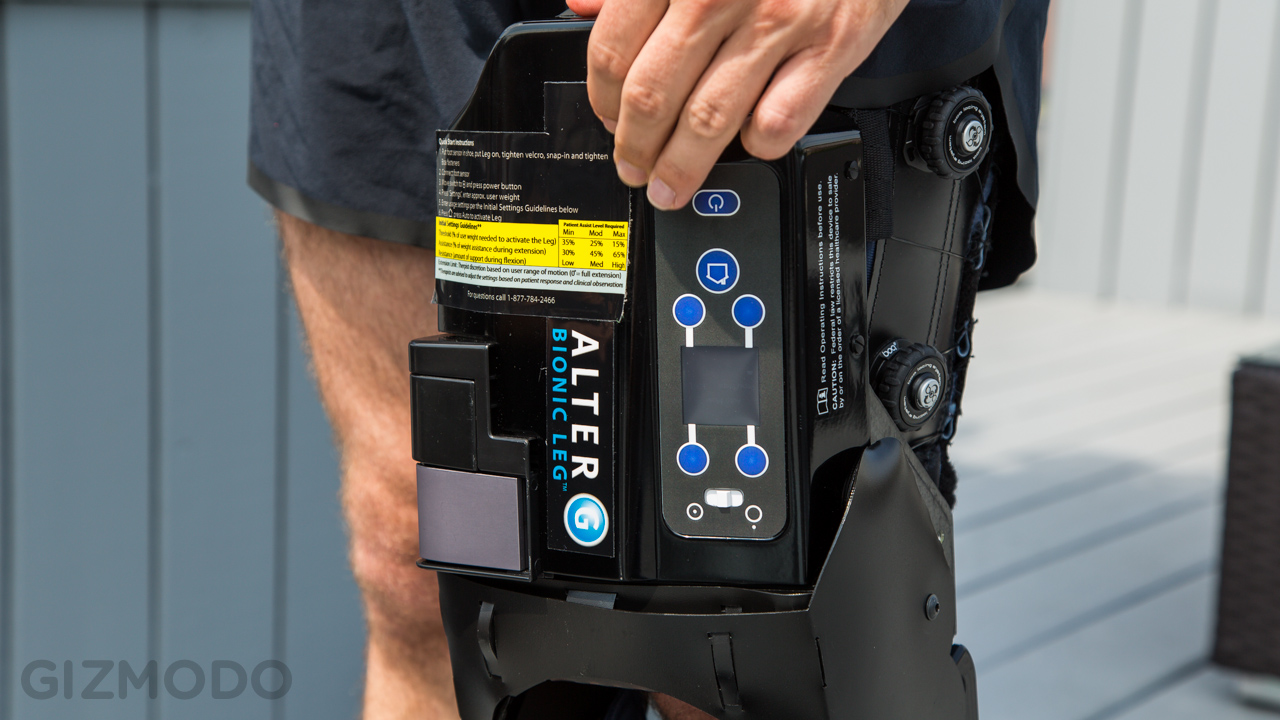
Something to note is that this isn’t a solution for a fully paralysed leg. Because the actuation is triggered by your leg’s movement and pressure on your foot, you must have at least some control over it. On the plus side, this means that the Bionic Leg doesn’t require any hand controls, and more closely mimics natural movement.
The whole thing runs off an internal battery pack, so there are no wires limiting your mobility. Want to practice getting in and out of your car? No problem. This also means that a physical therapist could bring the Bionic Leg to a patient’s home, so he or she could get used to climbing that tricky spiral staircase.
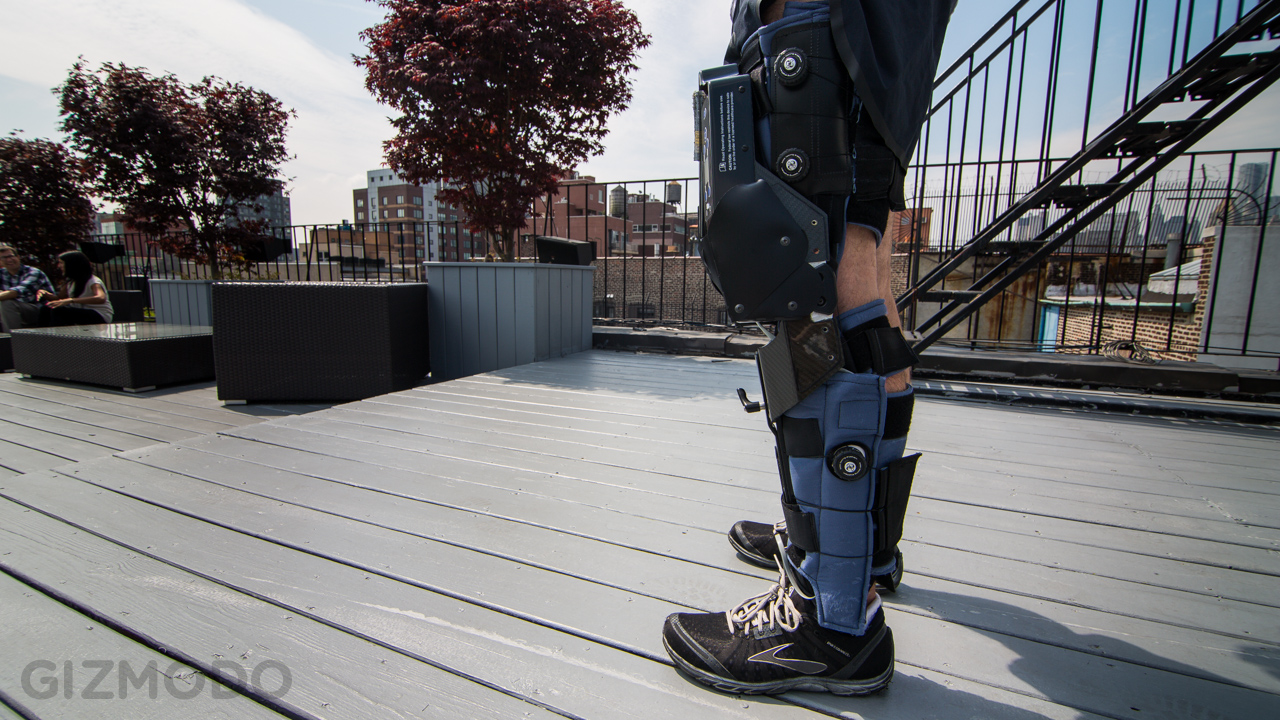
Using It
“WHAT!?” was my first reaction, followed closely by, “I have never, in my entire life, felt anything like this,” followed in turn by, “I. Am. Robocop.” Even at just 30-percent assistance the leg felt eerily powerful. Going up stairs was shockingly easy, as was sitting down, and standing up again. The part I found most unbelievable, though, was how it responded almost as quickly as my other leg. It was so responsive that it actually felt like it was a part of me.
One of the first things you notice are the prominent robotic sounds the motors make. They’re not subtle, but here’s an interesting bit of backstory: AlterG had the capability of making the motors much quieter, but physical therapists and patients actually preferred the more audible motors. It provides realtime feedback to them, so they can tell how much the motors are working and how much the patient’s leg is working. And yes, it definitely adds to the Robocopian element.
The one thing the Bionic Leg isn’t, however, is fast. I had fantasies of sprinting down the street like the Six Million Dollar Man and booting an 80-yard field goal, but alas, the leg has a maximum walking speed of just over two miles per hour. Considering it’s designed for low-level physical rehab, that’s really OK, but we’ll be dreaming of versions to come that actually allow you to run, or at least walk at a faster clip.
Note: Patients using the AlterG Bionic Leg must wear pants, both for comfort and hygienic reasons. I didn’t know that ahead of time and only had those running shorts for the demo. Pardon the pasty legshow.
Present and Future
Two (admittedly small) studies have been conducted using the Bionic Leg with stroke patients, one by UCSF and one by Columbia University. Both studies found that the patients made significant improvements in gait, balance, speed, ambulation, and functional performance. Significantly, both studies also concluded that patients who used the Bionic Leg were more likely to retain these improvements long after ceasing the therapy when compared to patients who used more traditional forms of rehabilitation. That is huge.
Currently, there are only 80 or so AlterG Bionic Legs in the United States, and they’re spread out all over the country. They are being used with great success on patients with everything from traumatic injuries to knee replacements to degenerative diseases to strokes and more. It costs approximately $US40,000 to buy one outright, though they can be rented for $US700 to $US1000 a month, depending on how much it will be used. Obviously, they are tools of rehab specialists, but AlterG is now in the process of ramping up production, so hopefully these devices will become more and more common at rehab facilities throughout the world.
In the meantime, it’s the closest I’ve ever felt to being a superhero. And that’s the best kind of breakthrough there is. [AlterG Therapy]
Video: Michael Hession
